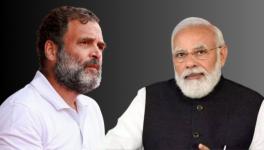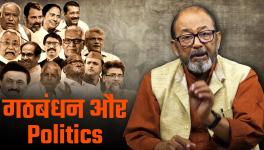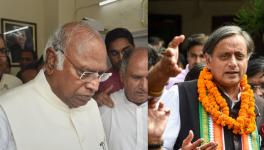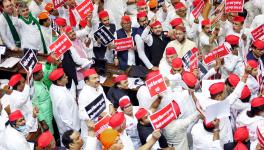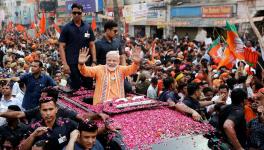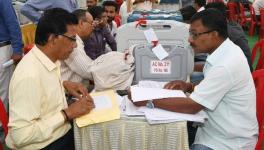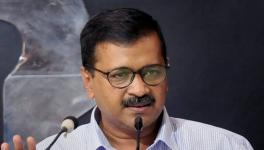Was Congress a Hurdle in Opposition’s Effort to Defeat BJP?
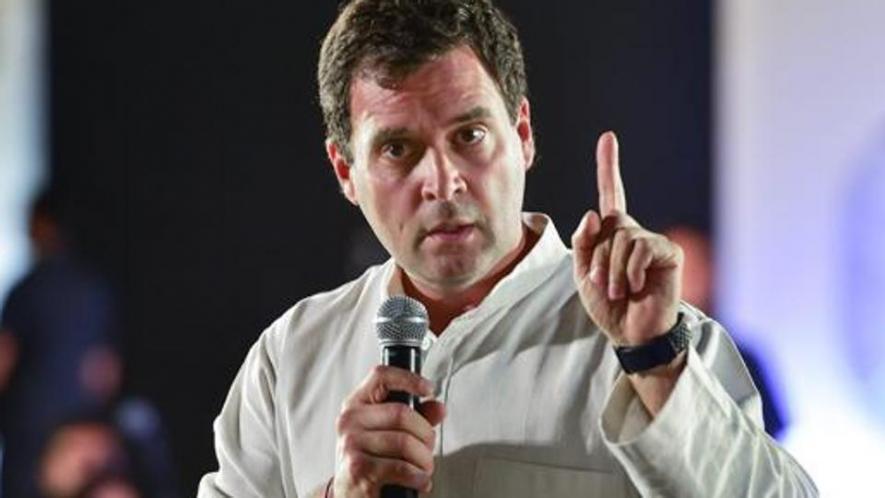
Image Courtesy: Hindustan Times
It is for the first time in the history of India that a non-Congress government has come to power with full majority for second time in a row. Interestingly, it is the Congress which created the stage from which the Bharatiya Janata Party (BJP) is now performing its best. Back then, it was the then prime minister Rajiv Gandhi who broke the locks of the disputed Ram Temple in Ayodhya on the eve of the 1989 elections and allowed the brick-laying ceremony in violation of a court verdict.
Today, it is the Congress president who can be blamed for playing a spoiler in Assam, Bihar, Delhi, Jharkhand, Maharashtra, Odisha, Uttar Pradesh and West Bengal. He shared the dais with Sitaram Yechury, Arvind Kejriwal, Chandrababu Naidu, Mayawati and Akhilesh Yadav but also decided to fight against them in West Bengal, Kerala, Tripura, Delhi, Andhra Pradesh, and Uttar Pradesh, eventually confusing party workers whether their priority is to defeat Modi or to strengthen the party.
Assam: In March, the All India United Democratic Front (AIUDF) supremo, Badruddin Ajmal, said that his party was not going to contest more than three seats in the Lok Sabha polls. He said the decision was aimed at stopping BJP from taking advantage of the division of “secular votes.” Ajmal had made repeated overtures to Congress for alliance prior to the 2016 Assembly polls. However, Congress paid no heed. AIUDF suffered a setback as the number of its seats reduced from 18 in 2011 to 13 in 2016. This time, too, Ajmal wanted an understanding with Congress. But former Assam chief minister and Congress leader Tarun Gogoi said AIUDF’s decision of contesting only three seats reflected that it had become weak. As a result, Congress contested all 14 seats but won just three and dented AIUDF’s prospects in Barpeta and Karimganj. Instead of contesting all the seats, had the Congress focused on winning Silchar, Autonomous District, Guwahati, Mangaldoi, Kaliabor, Jorhat, Dibrugarh, Lakhimpur and Tezpur, and had AIUDF concentrated on its campaigns in Karimganj, Dhubri, Barpeta, Nowgong and Kokrajhar, the possibility of the BJP-led National Democratic Alliance facing an erosion of votes in previously won Lok Sabha seats would have been higher.
Bihar: The BJP-Janata Dal (United)-Lok Janshakti Party combine’s sweep in Bihar can be attributed to a number of factors, the key one being the perfect synergy among the NDA allies. In contrast, the Grand Alliance comprising Rashtriya Janata Dal, Congress, Hindustan Awam Morcha, Rashtriya Loktantrik Samta Party and Vikassheel Insaan Party appeared to be muddled to the extent that some of their seats were allocated just five days prior to the elections. The Congress demanded 12 seats while it was accommodated in nine. The fact is that in Bihar, the last time the Congress won more than five seats was in 1984, after Indira Gandhi’s assassination. The RLSP, HAM and VIP were happy with the number of seats given to them but the Congress leaders were reportedly targeting RJD which sent a wrong message among its workers and damaged their image. RJD leader Tejashwi Yadav was compelled to call out Congress arrogance on Twitter.
Second, the caste combination with leaders like Upendra Kushwaha, Jitan Ram Manjhi and Mukesh Sahni looked good on paper but the decision to allot eight seats to these parties did not seem to go down well with RJD supporters. The RLSP, HAM and VIP being ex-NDA allies, were perceived to jump ships if BJP fell short of majority. Had the CPI and CPI(ML), which have significant presence in pockets of Bihar, were accommodated instead of these parties, then the alliance could have performed better. The CPI(ML) has three MLAs and in Bihar, it was a bigger party than LJP, RLSP, and HAM. The CPI (ML) and CPI had around 3% vote share in the state and, most importantly, their votes are not spread across the state but concentrated in certain belts (Ara, Siwan, Katihar for CPI (ML) and Begusarai-Mithila region for CPI making them more “winnable”. The RJD’s gamble on 17 seats (INC, RLSP, HAM, VIP) didn’t go down well with voters. Also, throughout the poll campaign, the cadres felt the absence of Lalu Prasad Yadav on the seats that the RJD contested.
Jharkhand: The Grand Alliance of the Congress, Jharkhand Mukti Morcha, Jharkhand Vikas Morcha -Prajatantrik and RJD failed to boost the morale of a large section of people, who were looking for a credible challenger to the NDA government. The last time Congress won a seat in Jharkhand was in 2009 when Subodh Kant Sahay defeated Ram Tahal Chaudhary of BJP. However, the Congress drew a blank in 2014 and secured a little over 10% votes in the 2014 Assembly elections. Yet this time it was allotted seven out of 14 Lok Sabha seats. JMM, the main opposition party, which secured over 20% votes in the Assembly elections, was allotted only four seats.
The Congress was the mainstay of the Opposition alliance in non-tribal segments, but was it organisationally ready to meet the challenge? It lost in four (Chhatra, Dhanbad, Hazaribagh, Ranchi) out of seven constituencies it contested, with a margin of 2.8 to 4.8 lakh votes. This shows that the Jharkhand Grand Alliance did not work on the ground in terms of transfer of votes and in cutting through the fault-lines of mutual competition among cadres for the same electoral segments, especially tribal ones.
The Godda constituency had considerable minority votes and one of the Congress contenders was Furqan Ansari, who won the seat in 2004. It was felt that he could have given a tough fight to BJP’s Nishikant Dubey but was denied a ticket this time to accommodate JVMP, which would have sent a wrong message to the minority community. The fortunes of JMM and JVMP and their influence in tribal segments did not also seem to have helped in the consolidation of votes in favour of the alliance, as a larger chunk of seats was allotted to a party with no mass support.
Maharashtra: After Prakash Ambedkar joined hands with AIMIM chief Asaduddin Owaisi to form the Vanchit Bahujan Aghadi (VBA) ahead of the Lok Sabha elections, the VBA was in talks with Congress-Nationalist Congress Party to form an alliance. But no concrete proposal emerged for a tie-up. The VBA was keen on an alliance with Congress only to prevent BJP-RSS from coming back to power. Ambedkar reiterated that there won't be any alliance with Congress unless it gave written proposal on bringing RSS under the constitutional framework. Although the Congress has said that it was VBA’s ‘unrealistic’ demand for 23 seats that failed in stitching an alliance, it also felt that associating with a front that includes Owaisi could upset Hindu voters and the emergence of VBA as an attempt to consolidate the Muslim-Dalit vote would harm the prospects of Congress and NCP in the long run. Eventually, the Congress may have dented the VBA’s prospects in Akola and Sangli constituencies where it was doing very well. The Congress secured just a single seat while NCP won four seats. Had Congress entered into alliance with VBA, the chances of winning the Buldhana, Gadhchiroli-Chimur, Hingoli, Nanded, Parbhani and Yavatmal-Washim seats would have been brighter. Most importantly, the 14% vote share for VBA shows there is space for an alternative apart from Congress-NCP and BJP-Sena in the state.
Uttar Pradesh: The Uttar Pradesh results indicate that the Mahagathbandan, comprising Samajwadi Party, Bahujan Samaj Party and Rashtriya Lok Dal, left more seats to Congress than they deserved, as it managed to win just Rae Bareli. Was it right on Congress’s part to contest more than 70 seats? If it was not strong enough to defeat the BJP, shouldn’t it have extended support to a party that had the capacity to take on the BJP? Such a stand would have helped the party’s stature among voters as well as among the Gathbandhan parties. However, Congress’s ‘arrogance’ could have harmed SP’s prospects in Badaun, Banda, Barabanki, Bareilly, Chandauli, Faizabad, Kairana, Mirzapur, and Robertsganj. The BSP, on the other side, suffered setbacks in Aonla, Basti, Bijnor, Bhadohi, Dhauraha, Domariyaganj, Machhlishahr, Meerut, Mohanlalganj, Pratapgarh, Sant Kabir Nagar, Sitapur and Sultanpur. Had the Congress shown some magnanimity, the Mahagathbandhan would probably have not lost 23 seats.
West Bengal: The vote share of BJP in Bengal in 2014 Lok Sabha elections was 17.2%. In the 2016 Assembly elections, the Left Democratic and Secular Alliance comprising CPI(M), CPI, RSP, AIFB and Congress emerged as an alternative to Mamata Banerjee’s Trinamool Congress (TMC) by securing almost 38% votes and bringing BJP down to 10%. Although, the votes did not translate into the expected number of seats, it did indicate that voters had shown trust in someone apart from Mamata Banerjee and Narendra Modi.
The Congress vote in the state is concentrated in a few districts, while the Left voters were spread across. As the CPI(M) transferred votes, the Congress became stronger in those pockets and won with a margin of over 30,000 votes in Kaliaganj, Ratua, Manickchak, Maldaha, Mothabari, Sujapur, Raninagar, Khargram, Beldanga and Durgapur Pashchim, and more than 50,000 votes in Raiganj, Chanchal, Lalgola, and Baharampur. The party won 44 seats and its 22 seats were only from Murshidabad and Maldaha districts. However, the Congress was either unable to transfer its vote or simply had too few votes to make a difference. In fact, the highest victory margin of CPI(M) was in Nabagram constituency with 38,066 votes. After the reduction of seats in Left’s tally, the CPI(M) could not continue the alliance, but it made another attempt for damage control in the 2019 Lok Sabha elections by offering a seat sharing arrangement to Congress on condition of “No mutual contest” on the existing parliamentary seats.
In Baharampur, Jangipur, Malda Dakshin, Malda Uttar, Murshidabad and Raiganj, the combined vote share of Left and Congress was more than that of TMC as well as BJP in the 2014 Lok Sabha and 2016 Assembly elections. In Alipurduar, Birbhum, Jalpaiguri, Krishnagar and Purulia, the combined vote share of Left and Congress was more than TMC and BJP in the Lok Sabha polls but not the Assembly polls. Finally, in Bardhaman Purba, Cooch Behar and Diamond Harbour, the combined vote share of Left and Congress was behind the TMC in both Lok Sabha and Assembly polls by an extremely narrow margin.
The maximisation of votes against BJP in Bengal was the need of the hour but the Bengal unit of Congress claimed that an alliance with either CPI(M) or Trinamool Congress would not serve the party’s "long term" interests. The Bengal Congress chief Somen Mitra went to the extent of saying, “We may not win many seats but our party will continue to exist in Bengal in the future.” If that understanding between Left and Congress had not been broken in 2016, and converted into a stable state-level political alliance, accompanied by constant booth-level coordination, and nurtured at the grass-roots for the last three years, then the 2019 results would probably have resisted the rise of BJP and rout of Left and Congress.
In Karnataka, Congress and Janata Dal-Secular squabbled over seats which damaged both sides and helped BJP propaganda about the ‘inability’ of Congress allies to form a stable government. The JD(S) wanted to contest 12 of the 28 seats, but the Congress was not ready to concede more than six seats. Even in Manipur and Tripura, the Congress could have won two out of four seats if it had allied with Left parties. The party is being even blamed for hurting the prospects of Telangana Rastra Samiti and Biju Janata Dal in Telangana’s Karimnagar, Nizamabad and Secunderabad and Odisha’s Balasore, Bargarh, Bolangir and Sambalpur, respectively.
Also, the NYAY scheme came too late and failed to percolate to the masses, even in the states where Congress held power. The biggest setback for me as a political observer was to see Congress celebrate its victory over the Left in Kerala whereas its job was to fight the fascists. The Congress, which may have ruined the prospects of around 90 Opposition seats, had no clarity on alliances days before the elections and no organisational preparedness to take on the BJP’s well-oiled electoral machine.
The writer is an independent researcher and journalist. The views are personal.
Get the latest reports & analysis with people's perspective on Protests, movements & deep analytical videos, discussions of the current affairs in your Telegram app. Subscribe to NewsClick's Telegram channel & get Real-Time updates on stories, as they get published on our website.









